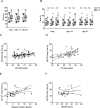Slower saccadic reading in Parkinson's disease
- PMID: 29364897
- PMCID: PMC5783375
- DOI: 10.1371/journal.pone.0191005
Slower saccadic reading in Parkinson's disease
Abstract
Idiopathic Parkinson's Disease (PD) is characterized by degeneration of dopaminergic and other neurons, leading to motor and non-motor deficits. Abnormal eye movements in PD, including fixations, saccades, and convergence, are well described. However, saccadic reading, which requires serial and alternating saccades and fixations, is not well studied, despite its obvious impact on the quality of life. In this study, we assessed saccadic reading using variations of the King-Devick (KD) test, a rapid single digit number naming test, as a way to assess the ability to make serial left-to-right ocular motor movements necessary for reading. We recruited 42 treated PD patients and 80 age-matched controls and compared their reading times with a variety of measures, including age, duration of disease, Unified Parkinson's Disease Rating Scale (UPDRS), the National Eye Institute 25-Item Visual Functioning Questionnaire 25 (VFQ-25), and Montreal Cognitive assessment (MoCA) test. The subjects performed 4 trials of reading 120 single digit numbers aloud as fast as possible without making errors. In each trial, they read 3 pages (KD1, KD2, and KD3), and each page contained 40 numbers per page in 8 lines with 5 numbers/line. We found that PD patients read about 20% slower than controls on all tests (KD1, 2, and 3 tests) (p < 0.02), and both groups read irregularly spaced numbers slower than regularly spaced numbers. Having lines between numbers to guide reading (KD1 tests) did not impact reading time in both PD and controls, but increased visual crowding as a result of decreased spacing between numbers (KD3 tests) was associated with significantly slower reading times in both PD and control groups. Our study revealed that saccadic reading is slower in PD, but controls and PD patients are both impacted by visuospatial planning challenges posed by increased visual crowding and irregularity of number spacing. Reading time did not correlate with UPDRS or MoCA scores in PD patients but significantly correlated with age, duration of disease, and VFQ-25 scores. The presence of convergence insufficiency did not significantly correlate with reading time in PD patients, although on average there was slower reading time in those with convergence insufficiency by 8 s (p = 0.2613). We propose that a simple reading task using 120 single-digit numbers can be used as a screening tool in the clinical setting to assess functional ocular motor difficulties in Parkinson's disease that can have a profound impact on quality of life.
Conflict of interest statement
Figures


Similar articles
-
Eye Tracking in Parkinson's Disease: A Review of Oculomotor Markers and Clinical Applications.Brain Sci. 2025 Mar 31;15(4):362. doi: 10.3390/brainsci15040362. Brain Sci. 2025. PMID: 40309816 Free PMC article. Review.
-
Slowing of number naming speed by King-Devick test in Parkinson's disease.Parkinsonism Relat Disord. 2014 Feb;20(2):226-9. doi: 10.1016/j.parkreldis.2013.10.009. Epub 2013 Oct 18. Parkinsonism Relat Disord. 2014. PMID: 24269283 Free PMC article.
-
A simple saccadic reading test to assess ocular motor function in cerebellar ataxia.PLoS One. 2018 Nov 7;13(11):e0203924. doi: 10.1371/journal.pone.0203924. eCollection 2018. PLoS One. 2018. PMID: 30403759 Free PMC article. Clinical Trial.
-
Abnormal eye movement behavior during reading in Parkinson's disease.Parkinsonism Relat Disord. 2016 Nov;32:130-132. doi: 10.1016/j.parkreldis.2016.08.008. Epub 2016 Aug 12. Parkinsonism Relat Disord. 2016. PMID: 27592009 Free PMC article.
-
Saccadic eye movements in Parkinson's disease.Indian J Ophthalmol. 2014 May;62(5):538-44. doi: 10.4103/0301-4738.133482. Indian J Ophthalmol. 2014. PMID: 24881597 Free PMC article. Review.
Cited by
-
Contrast Acuity and the King-Devick Test in Huntington's Disease.Neuroophthalmology. 2019 Nov 25;44(4):219-225. doi: 10.1080/01658107.2019.1669668. eCollection 2020. Neuroophthalmology. 2019. PMID: 33012907 Free PMC article.
-
Eye Movement Alterations in Post-COVID-19 Condition: A Proof-of-Concept Study.Sensors (Basel). 2022 Feb 14;22(4):1481. doi: 10.3390/s22041481. Sensors (Basel). 2022. PMID: 35214383 Free PMC article.
-
Reading Difficulties in Parkinson's Disease: A Stepped Care Model for Neurovisual Rehabilitation.J Parkinsons Dis. 2023;13(7):1225-1237. doi: 10.3233/JPD-230124. J Parkinsons Dis. 2023. PMID: 37781818 Free PMC article.
-
Management of Visual Dysfunction in Patients with Parkinson's Disease.J Parkinsons Dis. 2020;10(s1):S49-S56. doi: 10.3233/JPD-202103. J Parkinsons Dis. 2020. PMID: 32741840 Free PMC article. Review.
-
Eye Tracking in Parkinson's Disease: A Review of Oculomotor Markers and Clinical Applications.Brain Sci. 2025 Mar 31;15(4):362. doi: 10.3390/brainsci15040362. Brain Sci. 2025. PMID: 40309816 Free PMC article. Review.
References
-
- Ganguly G, Chakrabarti S, Chatterjee U, Saso L. Proteinopathy, oxidative stress and mitochondrial dysfunction: cross talk in Alzheimer's disease and Parkinson's disease. Drug design, development and therapy. 2017;11:797–810. Epub 2017/03/30. doi: 10.2147/DDDT.S130514 ; PubMed Central PMCID: PMCPMC5358994. - DOI - PMC - PubMed
-
- Manenti R, Brambilla M, Benussi A, Rosini S, Cobelli C, Ferrari C, et al. Mild cognitive impairment in Parkinson's disease is improved by transcranial direct current stimulation combined with physical therapy. Movement disorders: official journal of the Movement Disorder Society. 2016;31(5):715–24. Epub 2016/02/18. doi: 10.1002/mds.26561 . - DOI - PubMed
-
- Pringsheim T, Jette N, Frolkis A, Steeves TD. The prevalence of Parkinson's disease: a systematic review and meta-analysis. Movement disorders: official journal of the Movement Disorder Society. 2014;29(13):1583–90. Epub 2014/07/01. doi: 10.1002/mds.25945 . - DOI - PubMed
-
- Zhang TM, Yu SY, Guo P, Du Y, Hu Y, Piao YS, et al. Nonmotor symptoms in patients with Parkinson disease: A cross-sectional observational study. Medicine. 2016;95(50):e5400 Epub 2016/12/16. doi: 10.1097/MD.0000000000005400 ; PubMed Central PMCID: PMCPMC5268024. - DOI - PMC - PubMed
Publication types
MeSH terms
Grants and funding
LinkOut - more resources
Full Text Sources
Other Literature Sources
Medical

